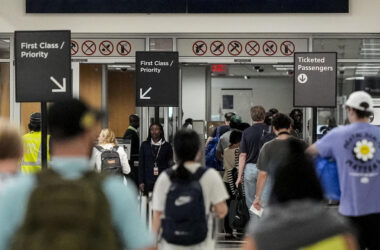American motorists may be paying significantly less at the pump this Labor Day, with gas prices expected to be the cheapest for the holiday in three years.
Continuing a recent downward trend, the average price of gas nationwide will fall to $3.27 per gallon on Labor Day, GasBuddy predicted in its annual travel forecast for the holiday. The projection has the price running 50 cents below the $3.77 average recorded a year ago, meaning motorists would be paying 13% less.
GasBuddy estimates Americans will spend roughly $750 million less at the pump this Labor Day than they did during the three-day weekend in 2023.
“It doesn’t feel too bad compared to two summers ago, when you could find the stray $6 price across Chicago,” Patrick De Haan, head of petroleum analysis at GasBuddy, told CBS News Chicago. “Prices have basically been in a free fall since mid-July,” he added.
Gas prices have been sliding since peaking at $3.69 a gallon in mid-April, with lower demand and fewer refinery outages helping keep a lid on costs. U.S. inventories of gasoline 3% above year-ago levels, according to the U.S. Energy Information Administration (EIA).
“We’re seeing perhaps the best opportunity in years for the national average to fall below $3 per gallon,” De Haan said in a statement.
Falling seasonal demand and cheaper winter gasoline is around the corner, De Haan noted, making it likely that tens of thousands of stations around the country could have sub-$3 gas closer to Thanksgiving.
“The arrival of September means cheaper winter-blend gasoline is almost here, which always helps take pressure off pump prices,” AAA’s Andrew Gross said. Lackluster demand and declining oil prices could cause gas to drop more, he added.
That said, prices vary depending on location. Weekly changes in regional costs can be found by looking at the CBS News price tracker.
Gas typically costs more on the West Coast because of factors including the region’s limited interconnections with other major refining centers (including the Gulf Coast) and requirements for gas specifications that are costlier to produce, according to the EIA.
Last month saw storm-related refinery outages result in slight increases in gas prices in the Midwest.
In Florida, Hurricane Debby threatened Gulf Coast oil production after making landfall earlier this month, but ultimately did not significantly affect refinery activity or petroleum demand, the federal agency noted.
Gas prices are priciest in Hawaii, where a gallon averages $4.65, followed by California and Washington at $4.62 and $4.16, respectively, according to a rundown by AAA. In Nevada, a gallon of gas is averaging $3.96, and in Oregon, $3.79.
Conversely, gas is least expensive in Mississippi, where a gallon averages $2.88, followed by Oklahoma and Texas, where it averages $2.94. In Tennessee a gallon of gas runs $2.95, and in Louisiana it’s a penny more, at $2.96 a gallon.




